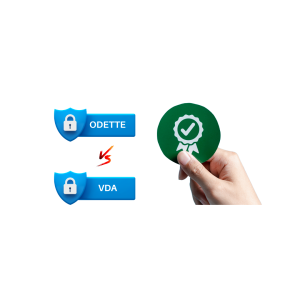Introduction
Historically, the grocery industry relied heavily on paper-based ordering, invoicing, and inventory management processes. This manual approach was prone to errors, time-consuming, and often resulted in delays and inefficiencies throughout the supply chain. The need for a more efficient system became apparent as the industry grew more complex, with an increasing number of products and faster turnover rates.
As profit margins tighten and consumer demands evolve, grocers and their suppliers constantly seek ways to streamline operations, reduce costs, and improve customer satisfaction. One technology that has emerged as a game-changer is Electronic Data Interchange (EDI) a transformative tool that streamlines supply chain operations enhances efficiency and promotes seamless communication across the supply chain. With a wide range of digital interactions, EDI transforms supply chains, nurtures collaborations, and fuels innovation, propelling the grocery sector into a new era of efficiency and responsiveness.
EDI acting as a digital bridge connecting suppliers, distributors, and retailers, has ushered in a new era in the grocery industry significantly reducing processing times, minimizing errors, and improving overall operational efficiency.
Key Takeaways
- EDI streamlines supply chain processes in the grocery industry, enabling faster and more accurate data exchange.
- It automates key operations like order processing, inventory management, and invoicing, reducing manual errors.
- EDI helps grocery businesses meet retailer compliance requirements, fostering stronger trading partner relationships.
- Real-time updates through EDI improve inventory tracking, minimizing stockouts and overstock issues.
- By enhancing efficiency and accuracy, EDI supports cost savings and better customer service in the grocery sector.
EDI Emerges as a Catalyst Reshaping the Very Fabric of the Grocery Industry
- Enhancing Efficiency and Accuracy
- Real-time Communication and Decision-Making
- Strengthening Partnerships and Collaboration
- Navigating Regulatory Challenges and Sustainability
1. Enhancing Efficiency and Accuracy
At the heart of the Grocery Industry’s transformation lies the profound influence of EDI in enhancing operational efficiency and accuracy. Manual processes, prone to errors and delays, are replaced with a seamless digital exchange of information. This transformation is exemplified through:
Streamlined Procurement: Through automated Purchase Order (EDI 850) transactions, retailers seamlessly communicate their product requirements to suppliers. This eradicates the inefficiencies of traditional order processing, minimizing delays and ensuring precise inventory replenishment.
Error Reduction: The Purchase Order Acknowledgment (EDI 855) and Advanced Shipping Notice (EDI 856) transactions ensure clear communication between retailers and suppliers. Errors arising from misinterpretation of orders or shipments are drastically reduced, fostering reliability and trust.
Efficient Billing and Payments: The Invoice (EDI 810) transaction digitizes the billing process, expediting payment cycles and reducing the risk of disputes. Accurate invoices enable timely and error-free financial transactions.
2. Real-time Communication and Decision-Making
EDI serves as the digital thread that weaves real-time communication throughout the grocery supply chain, enabling swift and informed decision-making:
Inventory Optimization: Through the Product Activity Data (EDI 852) transaction, retailers gain insights into sales trends and consumer preferences. This empowers informed inventory decisions, minimizing waste, and ensures products align with market demand
Responsive Supply Chain: The Advanced Shipping Notice (EDI 856) transaction offers retailers foresight into incoming shipments. This foresight facilitates efficient warehouse management, ensuring products are promptly available for sale.
3. Strengthening Partnerships and Collaboration
EDI’s impact transcends transactions, fostering robust relationships and collaborative ecosystems:
Supplier-Retailer Synergy: EDI nurtures transparency and mutual understanding between retailers and suppliers. This synergy paves the way for agile responses to market shifts and fosters mutual growth.
Enhanced Product Innovation: Real-time insights from EDI transactions enable retailers and suppliers to jointly respond to changing consumer preferences and swiftly introduce innovative products to the market.
4. Navigating Regulatory Challenges and Sustainability
EDI’s digitization plays a pivotal role in navigating the intricate web of industry regulations while promoting sustainability:
Regulatory Compliance: The Price/Sales Catalog (EDI 832) transaction ensures accurate pricing and product information, essential for complying with regulations and standards in labeling and pricing.
Environmental Responsibility: The shift from paper-based processes to digital EDI reduces paper usage, contributing to the grocery industry’s broader commitment to sustainable practices.
Types of EDI Transactions in the Grocery Industry
The grocery sector utilizes various EDI transactions to manage its complex supply chain. Some of the most common EDI transactions include
1. Purchase Order (850)
The Purchase Order (PO) transaction (EDI 850) serves as the industry’s bedrock, enabling retailers to request products from suppliers with precision. It outlines details such as product description, quantity, pricing, and delivery date. For instance, a grocery retailer submits an EDI 850 to a dairy supplier, specifying the number of milk cartons needed for the upcoming week.
2. Purchase Order Acknowledgment (855)
The Purchase Order Acknowledgment (EDI 855) is a responsive dance move in the EDI ballet, confirming the receipt and acceptance of a purchase order. Suppliers communicate their acknowledgment of the order’s terms and conditions through this transaction, facilitating a transparent agreement between parties.
3. Invoice (810)
The Invoice transaction (EDI 810) encapsulates the financial aspect of the grocery dance, providing an electronic rendition of the traditional paper invoice. Suppliers send EDI 810s to retailers, detailing the cost of products delivered, applicable taxes, and any discounts. This automation expedites payment processing and reduces the risk of errors.
4. Advanced Shipping Notice (856)
The Advanced Shipping Notice (EDI 856) is akin to a prelude, heralding the impending arrival of goods. Suppliers send this transaction before shipment, furnishing retailers with crucial details like tracking numbers, shipment contents, packaging information, and estimated delivery times.
5. Product Activity Data (852)
The Product Activity Data (EDI 852) transaction allows suppliers to share valuable insights with retailers. It includes information on sales, inventory levels, and consumer demand trends, enabling retailers to fine-tune their inventory management and make data-driven decisions.
6. Functional Acknowledgment (997)
The Functional Acknowledgment (EDI 997) might be considered the graceful bow at the end of each interaction. It serves as a receipt confirmation for every EDI transaction, ensuring that messages are successfully received and processed.
7. Price/Sales Catalog (832)
The Price/Sales Catalog (EDI 832) transaction showcases the offerings on the grocery stage. Suppliers provide detailed product information, pricing, and promotional data to retailers, facilitating accurate pricing and product display across various platforms.
8 Benefits of Using EDI in the Grocery Industry
1. Efficiency and Accuracy
EDI has emerged as a cornerstone of operational efficiency in the Grocery Industry. By automating the exchange of crucial business documents such as purchase orders, invoices, and shipping notifications, EDI minimizes manual data entry and reduces the risk of errors. This results in enhanced accuracy, faster transaction processing, and reduced operational costs.
2. Real-time Communication
In an industry where timely information is paramount, EDI facilitates real-time communication among suppliers, distributors, and retailers. Inventory levels, order statuses, and product availability can be swiftly communicated, allowing stakeholders to make informed decisions and respond to market demands promptly.
3. Inventory Management and Demand Forecasting
EDI empowers grocery retailers to optimize inventory management and demand forecasting. By sharing sales data and consumption patterns, suppliers can adjust production and distribution strategies, accordingly, ensuring that shelves are stocked with the right products at the right time.
4. Reduced Paperwork and Environmental Benefits
The adoption of EDI reduces the reliance on paper-based processes, leading to a significant reduction in paperwork and associated costs. This transition to digital documentation aligns with sustainability efforts, contributing to a greener and more environmentally conscious industry.
5. Enhanced Supplier Relationships
EDI fosters stronger relationships between retailers and suppliers. The streamlined flow of information and collaborative approach nurtured by EDI result in improved communication, transparency, and mutual trust, paving the way for mutually beneficial partnerships.
6. Compliance and Traceability
The Grocery Industry operates under stringent regulations and quality standards. EDI enables swift compliance by ensuring accurate documentation, certifications, and traceability records are maintained and readily accessible.
7. Minimized Out-of-Stock Situations
Out-of-stock scenarios can be detrimental to both customer satisfaction and revenue. EDI facilitates swift replenishment by enabling automatic reorder triggers based on predefined inventory levels, reducing the occurrence of stockouts.
8. Market Agility and Innovation
EDI’s agile communication framework allows the Grocery Industry to adapt swiftly to changing market conditions and consumer preferences. It paves the way for the rapid introduction of new products and innovations, keeping retailers competitive in a dynamic market landscape.
Conclusion
As the industry continues to evolve, with increasing emphasis on omnichannel retail, sustainability, and product traceability, the role of EDI is likely to become even more crucial. Grocery businesses that embrace EDI and continue to optimize their use of this technology will be well-positioned to thrive in the dynamic and challenging grocery marketplace of the future.
While implementing EDI may present initial challenges, the long-term benefits in terms of operational efficiency, cost savings, and improved trading partner relationships make it a worthwhile investment for grocery businesses of all sizes. As we move forward, EDI will undoubtedly continue to play a pivotal role in shaping the future of the grocery industry, driving innovation, and enhancing the shopping experience for consumers worldwide.
Commport EDI Solutions
Need Help? Download: EDI Buyers Guide
Unlock the full potential of your supply chain with our comprehensive EDI Buyer's Guide — your first step towards seamless, efficient, and error-free transactions
Frequently Asked Questions
EDI ensures compliance with industry standards like GS1 for product identification and data formatting. This simplifies integration across supply chain partners and ensures adherence to regulatory requirements.
EDI fosters better collaboration between grocery retailers and suppliers by ensuring timely and accurate communication. This reduces disputes, enhances trust, and helps maintain consistent product availability.
EDI streamlines supply chain operations by automating communication between suppliers, distributors, and retailers. It reduces manual processes, enhances order accuracy, and speeds up order fulfillment, which is critical for perishable goods.
EDI enables real-time data exchange, helping grocery retailers track inventory levels accurately. This prevents overstocking or stockouts and ensures shelves are stocked with fresh products, meeting customer demands effectively.
Yes, EDI reduces the need for paper-based transactions, contributing to sustainability efforts by lowering carbon footprints and waste. Automated processes also increase operational efficiency, further supporting eco-friendly initiatives.





